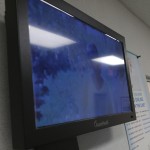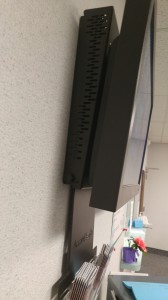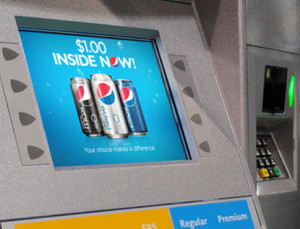Are you thrilled that you can skip over TV ads with your DVR and squelch online ads with an ad-blocker?
Don’t get too cocky!
As you read this, advertisers are striking back all over the place with in-your-face ads that you literally can’t avoid because—as they boast on Madison Avenue—you’re captive.
That’s right: Outside your home, there are still ads that you must listen to or watch whether you like it or not.
Here are three places where, recently, captive advertising nearly drove me to shout, like Howard Beale in Network, “I’m mad as hell and I’m not going to take this anymore.”
The doctor’s waiting room
There I was, stuck waiting for a friend to complete a diagnostic test that might take as long as an hour. Fortunately, I had brought reading material. Unfortunately, the waiting room was equipped with a Tv that blared ads and educational videos too loudly for me to concentrate on anything else.
The Tv shown to the left was supplied free to the doctor by AccentHealth, a service calling itself “America’s Leading Waiting Room Media Network.” In other doctors’ waiting rooms in which I’ve been stuck, at least there were remotes handy to lower the sound volume.
Not in this one.
So I checked all around the Tv unit itself for sound controls. As you can see from my second photo, whatever controls it might have had were kept out of reach behind a frame that enveloped the screen.
Clearly, AccentHealth didn’t want me—or any other “captive” viewer—lowering the volume.
Undaunted, I approached the office receptionist and asked if the volume could be turned down so that I could read. She told me that it could, but that she couldn’t do it because there was some complication or other involved.
Later I called AccentHealth to find out how anyone stuck in such a room could get the volume lowered. A customer rep told me that doing so would require someone on the doctor’s staff, possibly the office manager, to access special controls that AccentHealth had set up. That is, I thought to myself, if the staff knew how to do it and felt like bothering.
And so, I realized, the 173 million patients per year in the more than 30,000 physician waiting rooms that AccentHealth says it serves, are totally at the mercy of whatever intrusive volume each office permits.
And that’s exactly how the pharmaceutical companies who already bombard you with TV drug ads night and day want it. As one pharmaceutical industry marketing blog explained, in describing the benefit of advertising via AccentHealth:
“What if the very last word a patient heard before speaking to their doctor was “Lipitor,” “Advair,” or “Nexium”? What if Big Pharma could literally place a rep in the waiting room to whisper advice to patients as they crossed the threshold from waiting room to exam room? While this may not be entirely practical or possible, there’s at least one way such a dream can almost come true.”
Do doctors care about such intrusion in their patients’ privacy? I’d be surprised if many have any idea how loud the TV sound is in their waiting rooms. Or if more than a few office staffs have bothered to consider their patients’ need for quiet. As in so many areas of American life, commerce trumps privacy.
The gas station
I’m filling my gas tank at a SUNOCO station when the pump begins barking an ad at me. Turning to the pump, I see that the ad is also playing on a Tv screen. True, the screen shows brief news and weather reports, too. But even if I look away, I still have to listen to this junk. I’m helpless to leave before my tank is full. Advantage, Madison Avenue.
As advertising agency BlueLineMedia explains it:
“Advertising at a gas station is a great way to reach drivers in a captive setting. Drivers are standing around for an average of five to 10 minutes pumping gas — during which they can view gas stations ads, such as ads on top of the gas pump.”
There’s that word again: “captive.” Why is the U.S. “free” market so in love with this word? I wonder.
These ads must be effective because rates for 15 second spots on Gas Pump TV run “$1,195 to $1,395 per gas station per 4 week period (includes all TVs in station).” According to BlueLineMedia, gas pump ads are also found at many other major brands besides SUNOCO, although the ad agency didn’t say precisely which other gas stations run the especially aggravating Gas Pump Tv.
The NYC Yellow taxi cab
Whenever I get into a NYC Yellow cab, the Tv in the back seat is always on and squawking news, weather, and ads. That’s no accident; it’s designed to turn on whenever the meter starts up. True, there’s a Mute button somewhere on the screen. But by the time you settle into your seat, realize that it’s up to you to mute the sound, and locate an on-screen Mute button that actually works—assuming your ride hasn’t already come to an end–you’ve probably listened to more jabbering than the audience at a Heckle and Jeckle marathon. Taxi Tv has been in NYC cabs since 2007 and, more recently, in many other cities.
Cab riders hate it. (So do cabbies). A 2011 survey of riders by New York City’s Taxi and Limousine Commission found that Taxi Tv was disliked by 31 percent of riders, second only to high fares.
So why do advertisers pay, according to BlueLineMedia, $5,000 to $30,000 to run even a 15-second ad in an entire taxi fleet for 4 weeks? The advertising agency explains:
“Taxi television advertising is a relatively new format that breaks through the mold to reach passengers in a captive setting. Taxi TV ads are great for delivering a :15, :30 or :60 spot to people on the go.”
Captive, again???!
 Did you ever hear of Captive Nations Week? Maybe this commemoration of freedom lost should be expanded to include captive consumers.
Did you ever hear of Captive Nations Week? Maybe this commemoration of freedom lost should be expanded to include captive consumers.
One piece of good news: In October 2015, the NYC Taxi and Limousine Commission voted to start a pilot program to replace Taxi Tv in some cabs with something less intrusive. Hope springs eternal!
Lest you think that the three places above are somehow unusual in their ability to force-feed consumers advertising, consider this venue also pitched by BlueLineMedia:
“Advertising inside restrooms in restaurants and bars reaches a demographic that can’t be beat. Restroom advertising is a form of indoor advertising that is highly desirable and effective…Organizations and companies that succeed with restroom stall ads include those that sell packaged-goods, fast food and beverages.”
Now, that’s captive!
–Jeff Fox







